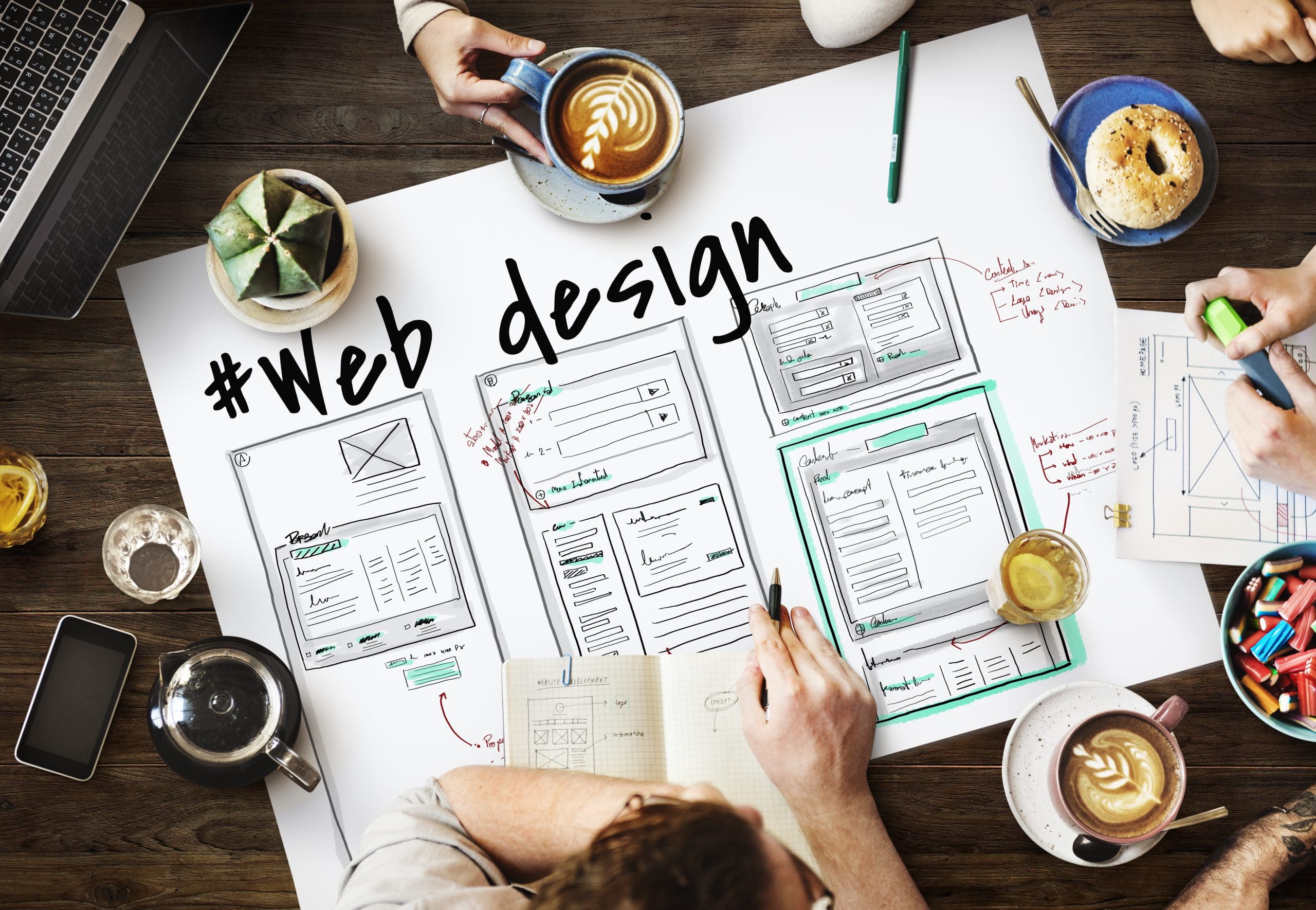How a web design company ensures accessibility and inclusivity for all users
Checking Out Creative Trends in Web Design for Modern Companies
The landscape of web design is constantly progressing, showing the vibrant demands of modern organizations. Recent fads highlight a choice for minimalism, strong typography, and engaging interactivity. Companies progressively focus on user experience via mobile-first concepts and individualized material. Furthermore, a concentrate on sustainability is acquiring grip. Recognizing these patterns is essential for companies aiming to attract attention in a congested market. What implications do these changes hold for the future of electronic engagement?
Welcoming Strong Typography
Bold typography has actually become a specifying component in contemporary web design, recording attention and communicating messages with striking clarity. This trend focuses on visually impactful text that enhances user engagement and brand name identification. Designers frequently make use of large fonts and special fonts to create a pecking order, guiding audiences with material flawlessly.
The tactical use bold typography allows for efficient storytelling, allowing brand names to connect their values succinctly. It offers not just aesthetic objectives however also functional ones, as it enhances readability throughout gadgets and screen dimensions.
As websites compete for user interest, bold typography attracts attention in a saturated digital landscape. Its adaptability allows developers to experiment with contrasting shades and formats, even more enhancing its performance. Ultimately, embracing bold typography represents a shift towards more expressive and communicative web design, promoting a deeper connection in between brands and their target markets.
The Rise of Minimalist Layout
As electronic settings come to be increasingly cluttered, the increase of minimal design provides a renewing alternative that focuses on simpleness and performance. This style approach strips away unnecessary aspects, enabling content to take spotlight. By concentrating on tidy lines, enough white area, and a minimal shade combination, minimalist style boosts user experience and improves navigating.
Services embracing this fad purpose to share their brand message clearly and efficiently, cultivating a feeling of calm and clarity. The absence of disturbances helps individuals concentrate on vital information, leading to boosted involvement and conversion prices. Furthermore, minimalist layout lines up well with mobile-first techniques, guaranteeing that websites continue to be user-friendly and accessible throughout various tools.
Eventually, the rise of minimal style reflects a more comprehensive shift in the direction of prioritizing user demands and choices, making it a powerful tool for contemporary services wanting to make a long lasting impact in the electronic landscape.
Immersive Animations and Interactivity
While several internet designers welcome minimalist visual appeals, another engaging trend getting grip is using immersive computer animations and interactivity. This method boosts user interaction by developing interesting experiences that attract visitors into the web content. Designers employ vibrant aspects such as computer animated histories, scrolling effects, and interactive infographics to connect complex ideas in an obtainable manner.
These computer animations not just supply aesthetic passion yet also overview individuals via the navigation process, making interactions more instinctive. For example, float results and computer animated changes can urge users to explore even more, resulting in enhanced time invested in the website.
Additionally, this pattern lines up with the wider motion towards narration in web design, where computer animations work as narrative devices that share brand name messages effectively. By incorporating immersive computer animations and interactivity, organizations can distinguish themselves in a jampacked online landscape, inevitably enhancing user satisfaction and brand name loyalty.
Mobile-First Style Principles
Mobile-first layout principles stress prioritizing user experience by guaranteeing sites work seamlessly on smaller screens. This technique includes responsive design techniques that adjust to various gadget sizes while maintaining aesthetic honesty. In addition, it concentrates on touchscreen navigation design, improving use for mobile users.
Focusing On User Experience
How can developers properly focus on user experience in a progressively mobile-centric globe? Highlighting mobile-first design concepts is important, as users mainly involve with sites with mobile devices. This approach motivates developers to streamline material, guaranteeing it is navigable and quickly obtainable on smaller sized screens. Secret methods consist of simplifying navigating, minimizing load times, and utilizing touch-friendly elements that improve interactivity. Additionally, prioritizing legible typography and intuitive designs can greatly enhance user satisfaction. Designers ought to constantly gather user comments to fine-tune their approaches, adjusting to advancing user requirements and preferences. By concentrating on these elements, organizations can create an appealing digital experience that fosters loyalty and drives conversions, inevitably lining up with the assumptions these days's mobile customers.
Receptive Design Methods
Developers accept responsive layout methods to produce adaptive and versatile internet experiences that accommodate different screen sizes. This method prioritizes mobile-first design concepts, guaranteeing peak functionality on smaller sized gadgets before scaling up for bigger displays. By utilizing fluid grids, adaptable photos, and media inquiries, designers can keep a cohesive aesthetic identification across all systems. This method not just have a peek at these guys enhances user involvement yet additionally boosts online search engine positions, as mobile-friendly sites are preferred by search formulas. In addition, receptive designs permit companies to reach a broader target market, suiting customers on desktops, mobile phones, and tablet computers alike. On the whole, implementing these techniques is essential for modern-day web design, making certain that businesses stay competitive in an Resources ever-evolving electronic landscape.
Touchscreen Navigating Style
With the increase of mobile phones, touchscreen navigating has come to be an essential facet of web design. Developers are significantly taking on mobile-first principles to improve user experience and involvement. web design company. Reliable touchscreen navigating prioritizes larger buttons and user-friendly motions, allowing individuals to interact quickly with material. This technique minimizes aggravation and encourages expedition, as customers can navigate effortlessly with their fingers. In addition, including swipe gestures and faucet capability deals with the all-natural actions of mobile individuals. Feedback mechanisms, such as aesthetic cues and computer animations, enhance use better by confirming activities. As touchscreens control user interactions, using these style components not only straightens with modern assumptions yet additionally cultivates an extra pleasurable and available searching experience for all users
Customized User Experiences
What makes an individual feel truly engaged on a web site? The response commonly lies in customized user experiences. By customizing content and navigating to specific choices, companies can produce a significant link with their target market. This personalization can be achieved with different methods, such as examining user actions, making use of cookies, and providing customized recommendations based on previous communications.
As an example, ecommerce platforms that recommend products based on surfing background not only boost user experience however additionally increase conversion prices. Incorporating dynamic content that adapts to the user's area or time of day can better enrich engagement.
Additionally, personalized introductions or messages can make customers really feel valued and recognized. As modern-day companies strive to stand apart in a competitive electronic landscape, embracing personalized user experiences comes to be crucial, fostering loyalty and encouraging repeat sees. Inevitably, this strategy transforms a standard web site into an interactive platform that resonates with its audience.
Sustainability in Web Design
As the digital landscape remains to progress, the value of sustainability in web design has actually obtained significant attention. Developers are progressively knowledgeable about the ecological influence their creations can have, prompting a shift in the direction of eco-friendly practices (web design company). Lasting web design concentrates on maximizing web sites to minimize energy usage and carbon footprints. Strategies include utilizing minimalistic style concepts, maximizing photos, and using reliable coding techniques to improve loading rates
The selection of hosting companies plays an essential duty; lots of developers are now deciding for environment-friendly hosting services powered by renewable power. By prioritizing availability and user-friendly navigation, sustainable styles likewise satisfy a more comprehensive audience, enhancing use. This conscious approach not just allures to environmentally-minded consumers but additionally contributes to the general long life and efficiency of websites. Inevitably, sustainability in web design shows a growing trend towards responsible digital practices that align with contemporary service worths.

Regularly Asked Questions
Exactly How Can I Choose the Right Color Design for My Web site?
To select the best color design for a web site, one must consider the brand's identification, target market, and psychological impact. Utilizing color theory and testing combinations can boost user experience and visual appeal considerably.
What Are the Finest Tools for Prototyping Website Design?
The most effective tools for prototyping web styles include Figma, Map out, Adobe XD, and InVision. These platforms provide instinctive interfaces, partnership features, and considerable libraries, making them perfect for designers to develop and fine-tune their principles successfully.
How Do I Determine the Performance of My Web Design?
To gauge web design performance, one ought to analyze user engagement metrics, conversion rates, and functionality responses (Web Design Agency). A/B screening and heatmaps can additionally supply understandings into user habits, directing essential news modifications for better performance and user experience
What Prevail Web Design Mistakes to Stay Clear Of?
Typical web design mistakes consist of messy layouts, bad navigation, slow packing times, absence of mobile optimization, inadequate comparison, and neglecting user feedback. Preventing these pitfalls boosts user experience and raises general performance of the website.
How Commonly Should I Update My Internet Site Design?
A site style need to be upgraded every two to 3 years, or quicker if significant changes in branding or innovation occur. Routine updates keep the website fresh, functional, and straightened with present user assumptions.
